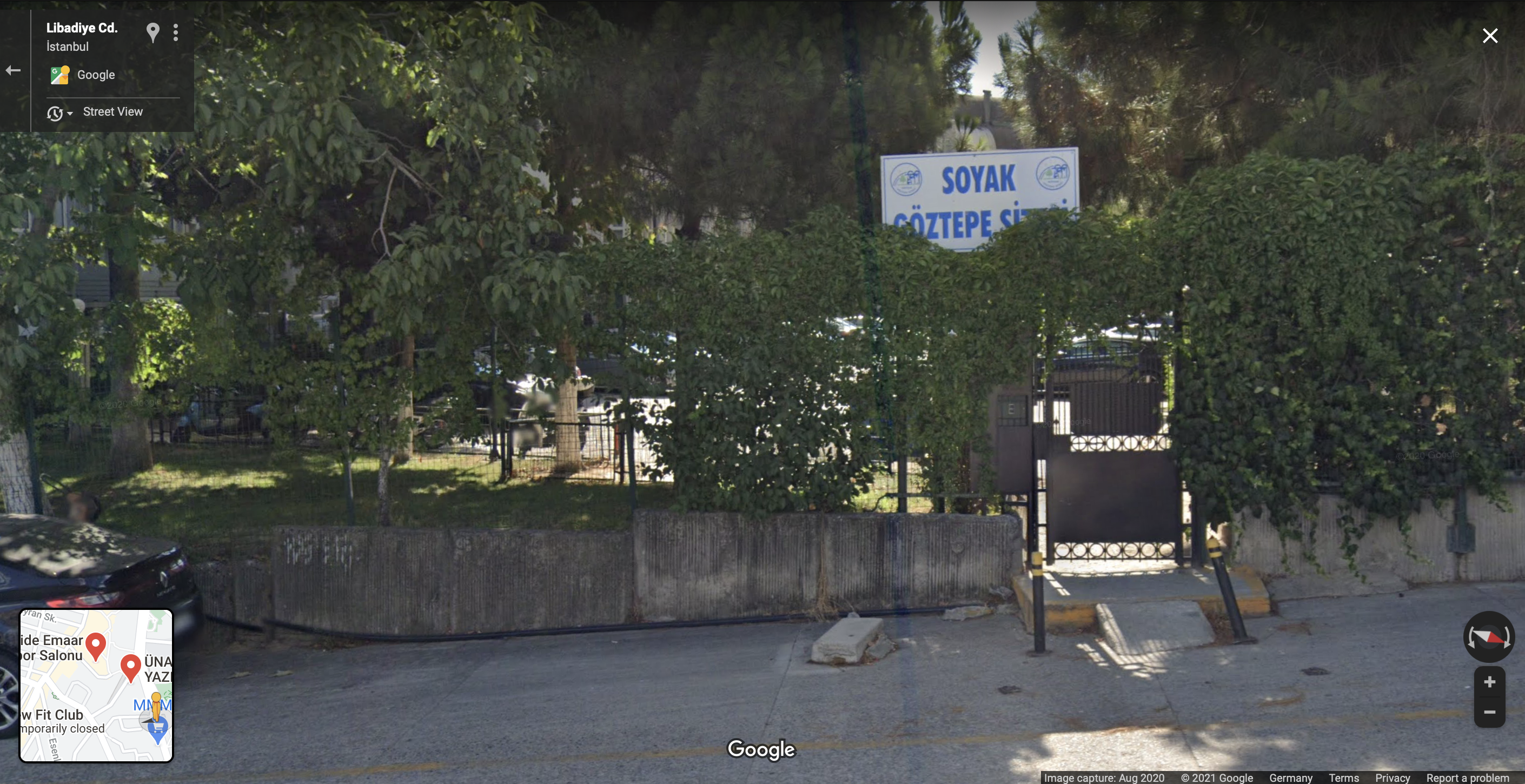
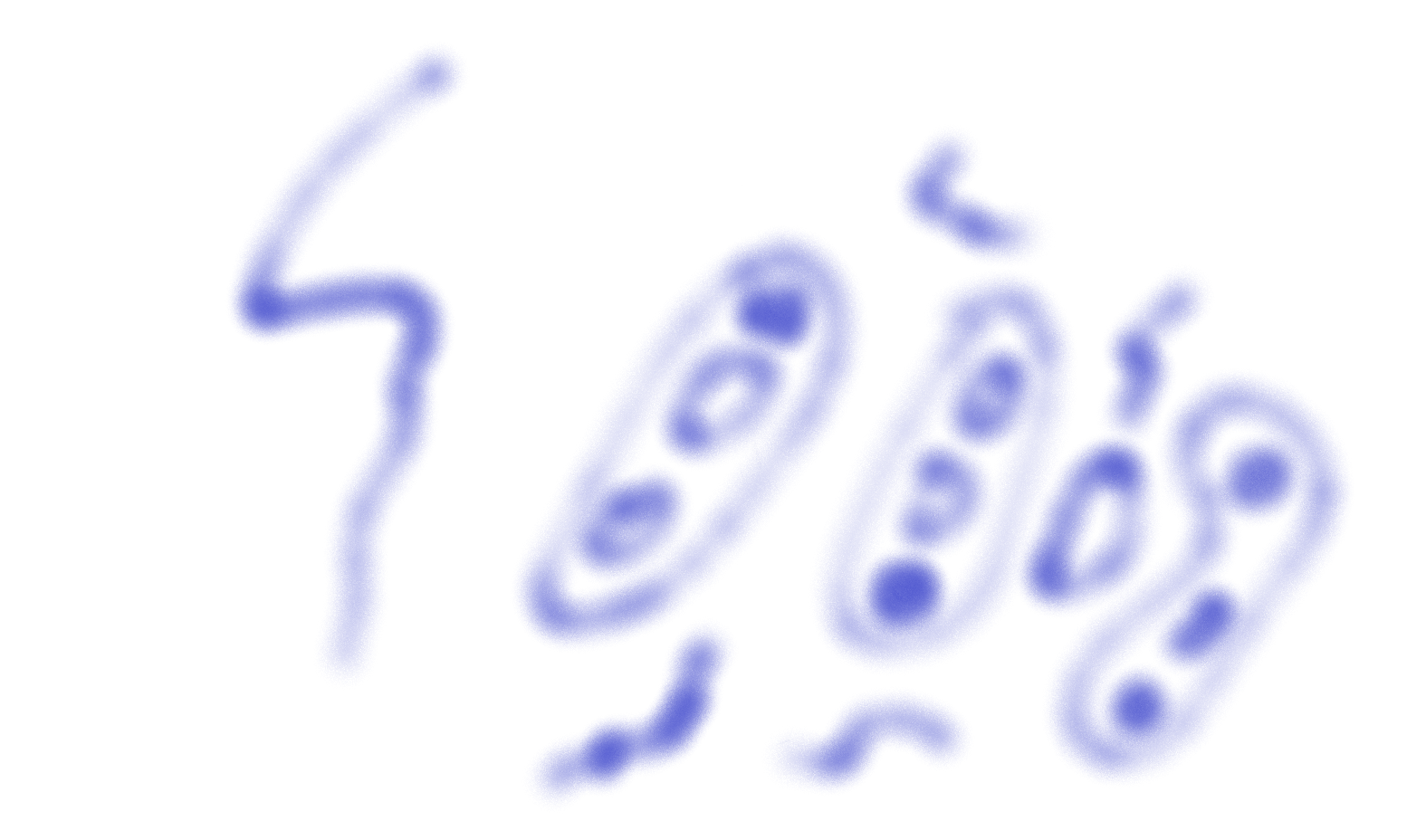
Site’s translation would be, a gated community, but this is one of the not-really-yet-gated ones, so I will refer to it by using the word site /síte/.
It is not that I have any kind of emotional connection with this site, with its monotype buildings, because I lived there in my childhood, but it is more like I want to say to it I acknowledge you and have respect for your being, the way you are. I believe you have gained more or less your grounding in your 30-something years lifetime, which is a commonality between us.



It was not until 2 years ago, that I got to see the other parts of the site for the first time, when I needed a new ID, as I was registered somehow still there.
Since as a kid, I didn’t have much agency to decide to go for a walk and it was something very rare to go for a walk inside the quite big site.
I, in those days, sometimes wondered how other parts of the site would look like, obviously more or less the same, but how same that would be.
I remember having some fantasies about weird and beautiful looking çardaks, the wooden garden furnitures that are put at that time in these kind of sites and I have a memory of sitting in one of them once or twice and feeling like in a very special and exotic place.



Last time, 2 years ago, when I was able to sight its other parts than where we lived, I was surprised that it was still very live, a new living emerged with its markets, Migros, some smaller shops and even a few people hanging outside.
It turned out to be a still living place, and not like the scenario I expected, that no more people would be living there, but keeping their houses to sell sometime when/if they would gain value one day and the buildings are probably lacking maintenance. Except a few younger white collar workers who end up living there because it is still affordable with their low but still middle class income.


In its advertising flyer from 1986, it says, Soyak takes its meaning and characteristics from ‘the nation’ and ‘traditions’; and its technicality from the ‘civilization’ and ‘the epoch’.
It says also, it has been shaped in the architectural sense of the traditional Turkish streets with well balanced cumbalar – the bay windows –.
It surprises me that there is no mention about the main characteristic, the dome-like burgundy rooftops of the buildings, and where they fit in between these concepts. Maybe they think it is too obvious that the rooftops manifest the mixture they wanted to depict.

As I wander through its streets today on Google maps, I see a security guard person, who seems to rush to somewhere. There are people with masks on the streets, it must be taken last summer. People are walking on its narrow streets, almost too narrow for a car to make a turn and the pedestrian walkway barely enough for one person to walk.
Google’s AI has blurred people’s faces, also among them is the head statue of Atatürk that is located in a tiny green area in the middle of the two lanes road, facing the cars passing by towards the exit.

Within a click, I face the communal election posters hanging and see a few people with lots of CHP (the social democrats) flyers in their hands and many more in half-open boxes on the pedestrian next to them, apparently waiting to be spread in the site soon. I firstly think that this must be from the 2019 municipal elections, but it turns out, the photo was taken in 2014. Google’s AI managed to blur the faces in the election posters, which augments the feeling of timelessness and being trapped in the same loop.
One more click brings me back to 2020, people with masks, ‘Migros Sanalmarket’ ‘Migros Virtual Market’ it reads on the partly orange cars gathered around Migros market.


In the next image I am already thrown out of the site, in the middle of the highway all of a sudden, which is because of one of Soyak’s features is that it is not a closed system in itself, unlike many gated communities from the last decade, it has many holes, no walls, allowing leaking totally.
It is possible to enter from these holes in between greens and you can easily find yourself outside of it from one moment to another.


Göztepe Soyak Sitesi is not in Göztepe, the district it is named after, but is located in Ünalan mahallesi, within the borders of Üsküdar. As the adjacent district Göztepe refers to a different class and topography with its much younger housing history accommodating newer houses built for the middle class on the former farms and fields, it was decided to name the site after Göztepe apparently, in order to make the buyers feel it is worth the money they pay and still belonging to the right class where they would like to be or stay.
A while ago, reading an interview with the labSurlab -a network of independent initiatives in South America- from the book ‘Provocative Alloys: A Post-Media Anthology’, one of the group members says, “We have never been modern, and if ever, then ‘postmodernity’ came first.” “…But for many if not all of those southern communities it is not a question of being ‘post’ or ‘modern’.
In the South such notions are somewhat imported, they land real-time within processes of hybridisation-pura”. This sentence stayed with me for some time after reading it, as it puts well together in words what finds its correspondence in south in a broader sense, Global South so to say.

These buildings don’t hide their concrete bodies by covering the facade with shields or marble or from bottom to top glasses and they don’t try to glorify it either.
They say “Hi, I am concrete and I am here”.
Intended as a unity in their design, these concrete bodies build a heterogeneous ensemble together, with their varying heights, bumpy street junctions, narrow pedestrian walkways, parked cars with their two wheels on these walkways, secret places around the small electricity houses, same but different looks of each balcony and window.
As a kid I was fascinated by these small electricity houses, that transform large amounts of power to smaller ones, and the labyrinth kind of paths that lead to them, made to keep them away from the looks. And sometimes they were hidden behind some greens. It was not yet a common practice to paint random figures colourfully on them to make them ‘disappear’. They looked so unpretentious, even if sometimes dirty, it was totally ok for them to look dirty. Them being so down to earth, makes it possible that Pongwiffy – a witch of dirty habits, the novel character from one of my favourite books at that time – could very well have lived around them.

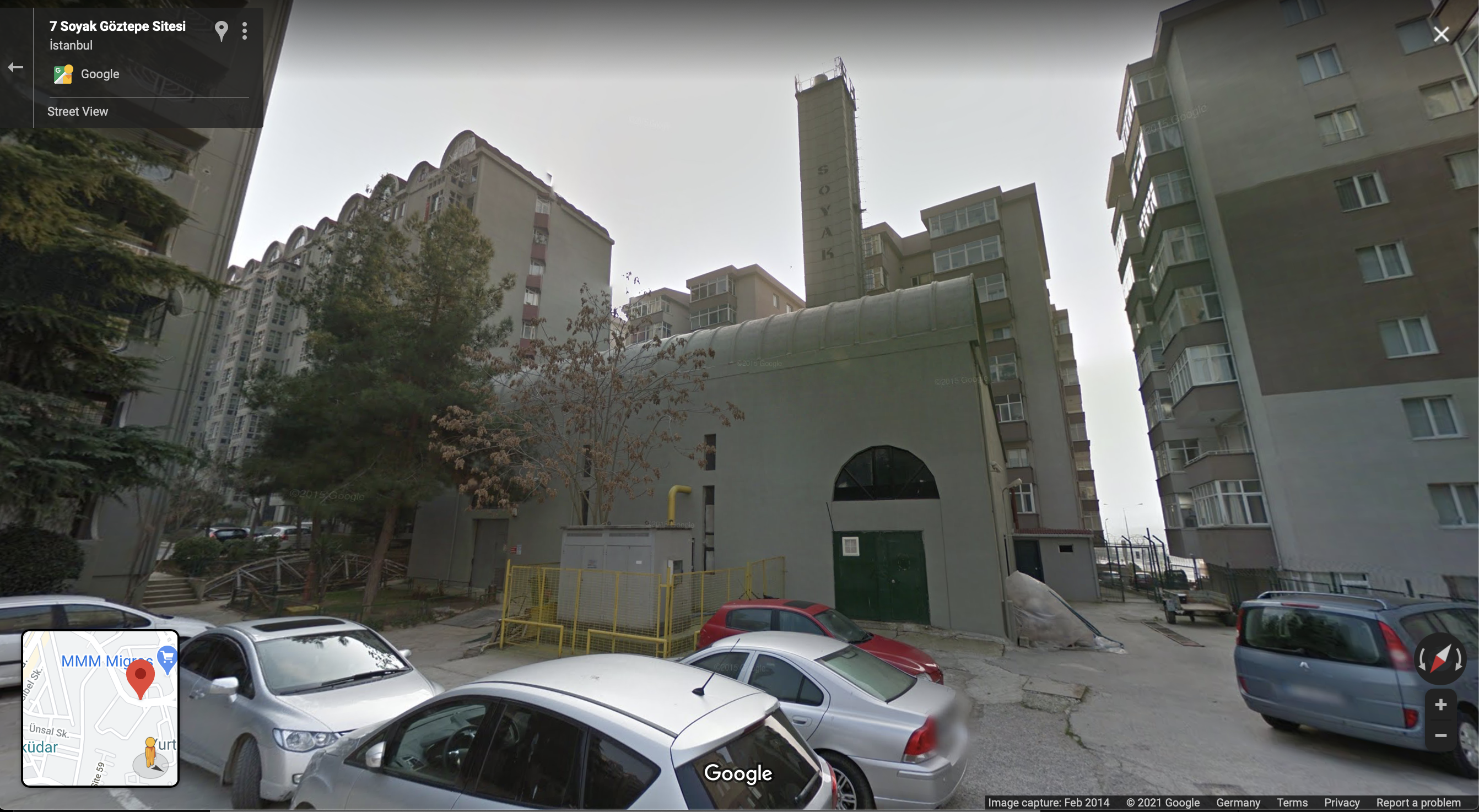
On the current website of Göztepe Soyak Sitesi, where the site is being described, I come across bunch of words like: ‘collective living spaces’, ‘site sakinleri – site inhabitants’ which almost sound like social realism. The language that is being used here seems to be stuck at around 80s-90s, whereas the new built gated communities sell themselves rather by practicing storytelling, making use of ‘your house, your home, your view’, ‘fitting to different needs of each’ and ‘living spaces’ in their experience descriptions. Not surprising not to see anything from ‘site’, ‘inhabitants’, let alone ‘collective’.


Walking on the streets on Google Maps another day, I encounter a few cats, not many, walking, sitting, standing. They all seem to be single for that time being, I don’t see them anywhere together cooking up anything.
Due to the topography of the area, the site is full of small hills, going up and down, hard to find any bigger zones that are flat. I remember these bumpy green spaces – the only greens other than the sport fields – in between the buildings and parking cars where it is hard to undertake any activity. But again, this makes this place less controllable by the safety guards. These spacial features of the site obviously haven’t been tried to overcome by flattening it and left like as it was – once a farm –.

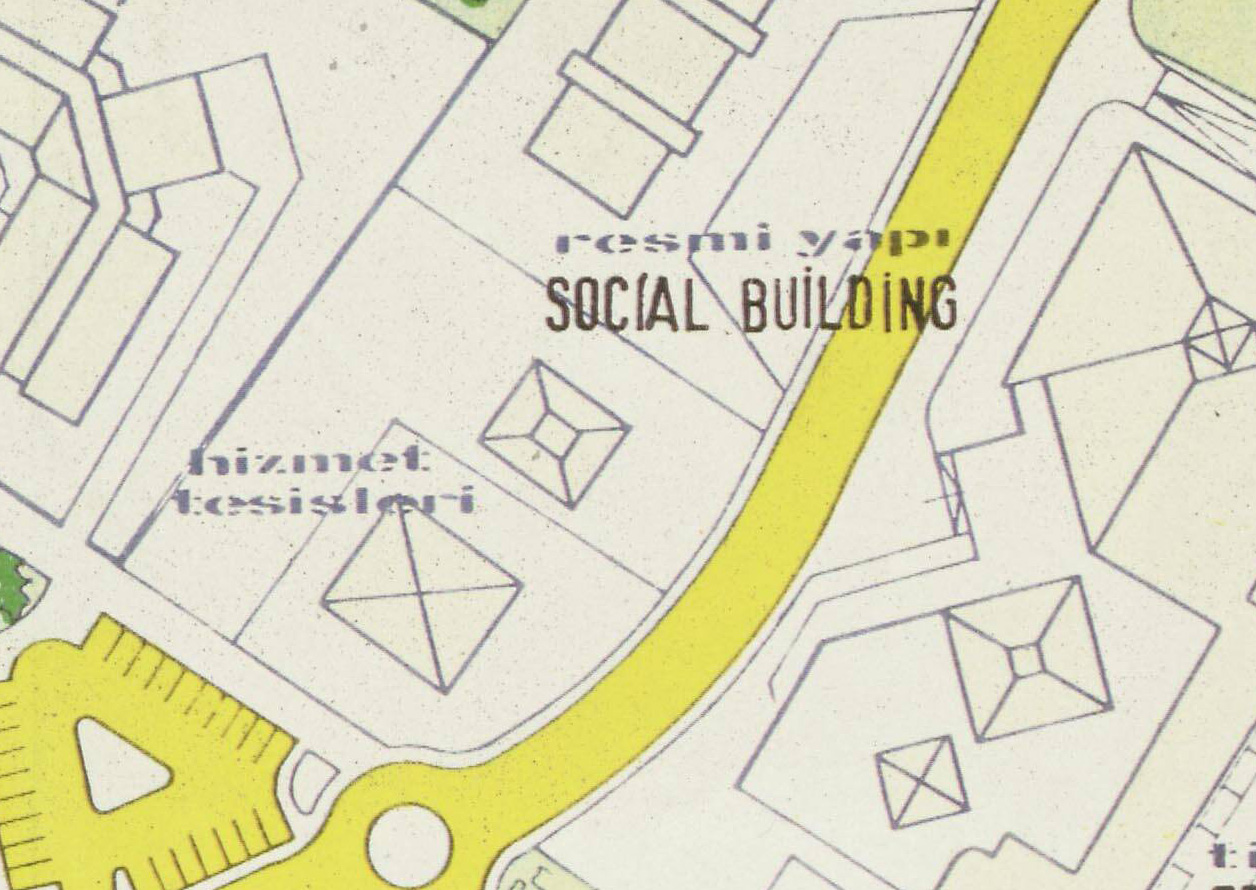
The fear from an earthquake that may occur in the Marmara sea determines in this city whether buildings are obsolete or condemned to be used by humans until the district begins to gain monetary value with the continual increasing amount of people searching for housing, pushed forward by continuously new built roads, metro stations, bridges or artificial seas. Then they are condemned to be tore down and replaced with a new and a bit more earthquake-resistant ones for another half century.
I find site’s architectural plan drawings linger in an internet archive of a cultural institute, open for public use. Its architects with their company built some of the state and university buildings in the 70s and 80s, in naked concrete look. Today the company designs luxury minimalist houses and company buildings all over Turkey. The one and only image of Soyak Sitesi on the company’s Instagram is a black and white grainy picture of its lined houses, taken with an analogue camera. The post says “When looking back”. Hashtag modernism. As if they would bury it alive.
The plan drawings of the site are hand-drawn with pen, pencil and coloured pencils in dark pink. The representation of plants and all kinds of greens have a standardised form in these landscape drawings. A circular form which is closed but cut from sides intentionally irregularly, conceived based on how the trees are supposed to look like in summer, as if taken by a satellite looking towards them.
Here, being hand-drawn, some of them overflown out of their templates, they have overall a spontaneity, an unregulated irregularity of a nearly sketchy romantic landscape study.

Liebe noch unbekannte Besucher*innen,
ich lade euch herzlich zu meinem Lesekreis "Common Voice Transmission" ein!
Während des ersten Lockdowns habe ich gemerkt, wie wenig ich spreche und auch noch schlechter. Deswegen habe ich angefangen Buch laut vor zu lesen, damit ich Deutsch nicht vergesse. Durch das Aussprechen leben die geschriebene Wörter viel mehr in mir und ich spüre die Kräfte vom Text. Ich möchte mit euch zusammen Bücher gegenseitig vorlesen und diese Erfahrung teilen.
Unten findet ihr eine Liste der Literatur und Datum zum Zusammen-Lesen (Änderungen vorbehalten).
Bitte schickt mir eine Mail mindestens 2 Wochen vor dem jeweiligen Lesekreis mit euer Adresse. Ihr bekommt dann das Buch zugeschickt und wir werden gemeinsam das Buch Abschnitt-weise lesen. Maximal 5 Teilnehmer*innen pro Lesekreis.
Anmeldung
Ich freu mich auf euch!
Liebe Grüße
Aiko
- 13. Juni 17 Uhr Radikale Zärtlichkeit - Warum Liebe politisch ist, Şeyda Kurt, HarperCollins, 2021
Variability of Distance or: Like Diamonds in the Sky
Text by Feben Amara
While acknowledging different modes of imposed immobility and settledness as our current state of existence, we aim to leave our cosmic home island, the earth, for expansive inquiry rather than territorial expansion. We are not at all interested in separating ourselves from our planetary be/longing. We are proposing to take a distanced look instead. To begin, so to say, a long-distance relationship with the world. And moreover: Why not break the sky’s ceiling and look for chaos elsewhere?
It is Édouard Glissant that reminds us, it is the notion of chaos that opens onto another phenomenon of our existence: “Relation, or totality in evolution, whose order is continually in flux and whose disorder one can imagine forever.” He illuminates furthermore, that what has become the common formula of our cultural interdependencies has not only been founded on the basis of physical thought (“The Theory of Relativity”) but is therefore deeply enrooted in the universe itself.
Galaxies – or “Welteninseln” (Alexander von Humboldt), which is relatable to the epistemological practice of “archipelagic thought” coined by Glissant – are chaotic infrastructures par excellence. For that, we have chosen to make them the imaginary framework of this project. As newly born planets, surrounded by gas and dust, moving away from our birthplaces and towards different stars, our existence becomes solitary yet solidary, not common but in relation.
And as we hold on to the earthly wickerwork of places and spaces, of humans and non-humans we feel dis/connected with, while we start off to explore the distances and intimacies of these relations, we therefore join an extraterrestrial kinship with the universe.
German version
Variabilität der Distanz oder: Like Diamonds in the Sky
Text von Feben AmaraWährend wir verschiedene Modi auferlegter Unbeweglichkeit und Sesshaftigkeit als unseren gegenwärtigen Daseinszustand anerkennen, streben wir danach, unsere kosmische Heimatinsel, die Erde, für eine expansive Betrachtung statt für einer territorialen Expansion zu verlassen. Wir sind keineswegs daran interessiert, uns von unserer planetarischen Zugehörigkeit zu trennen. Stattdessen schlagen wir vor, einen distanzierten Blick zu werfen, sozusagen eine Fernbeziehung mit der Welt zu beginnen. Und mehr noch: Warum nicht die Decke des Himmels durchbrechen und das Chaos woanders suchen?
Es ist Édouard Glissant, der uns daran erinnert, dass es der Begriff des Chaos ist, der uns noch ein anderes Phänomen unserer Zeit eröffnet: "Die Relation, oder die Totalität in der Evolution, deren Ordnung ständig im Fluss ist und deren Unordnung man sich ewig vorstellen kann." Er beleuchtet darüber hinaus, dass das, was zur gängigen Formel unserer kulturellen Verflechtungen geworden ist, nicht nur auf der Basis physikalischen Denkens ("Relativitätstheorie") begründet wurde, sondern somit tief im Universum selbst verwurzelt ist.
Galaxien - oder "Welteninseln" (Alexander von Humboldt), was sich auf die von Glissant geprägte erkenntnistheoretische Praxis des "archipelagischen Denkens" beziehen lässt - sind chaotische Infrastrukturen par excellence, und deshalb haben wir sie zum imaginären Rahmen dieses Projekts gemacht. Als neugeborene Planeten, umgeben von Gas und Staub, die sich von ihren Geburtsorten weg und zu anderen Sternen hin bewegen, wird unsere Existenz einsam und doch solidarisch, nicht gemeinsam, aber in Beziehung.
Und während wir an dem irdischen Geflecht von Orten und Räumen, Menschen und Nicht-Menschen festhalten, mit denen wir uns (nicht) verbunden fühlen, während wir uns auf den Weg machen, die Entfernungen und Intimitäten dieser Beziehungen zu erforschen, schließen wir uns also einer extraterrestrischen Verwandtschaft mit dem Universum an.
English version
Variability of Distanceis a collaborative project initiated by Andara Shastika, Ayfer Karabıyık and Paula Godínez,
made possible by its participating artists, culture producers, writers and organisers.
The project evolves from the structure Cura Han Hati (initiated in 2020 by Paula Godínez and Andara Shastika), which serves as a network for BPOC artists in and from Kassel to address structural racism in the culture industry, art schools and German bureaucracy; to exchange strategies to survive German immigration law as artists; as well as to occasionally collaborate in projects.
‘Cura’ is to be read in Spanish, as in ‘healing’.
‘Hati’ is Indonesian for ‘heart’, the emotional organ.
The name ‘Cura Han Hati’ stems from the Indonesian ‘curahan hati’, an activity of sharing problems with the people we trust. Translatable to ‘the spill (or the flow) of the heart,' a ‘curahan hati’ is essentially a spontaneous space to be listened to, supported, and empowered by each other; where problems are dealt personally, emotionally as well as practically and constructively.
Variability of Distance has been initiated out of the necessity to share resources and support each other in our own (artistic) practices, as the pandemic affects our community with a more complex economical and political dimension. Following collaborative processes of researching and organising, each participant of this project developed a work that departs from our multi-faceted experiences of distance: the physical distance, the temporal and conceptual distance in the aesthetic theory, as well as the geographical distance that inhabits the personal and the political at once.
Variability of Distance is funded as part of the cultural funding program „Hessen kulturell neu eröffnen“// Gefördert im Rahmen des Kulturförderprogramms „Hessen kulturell neu eröffnen“.
- Credits:
- 3D by Echo Luo Can
- Website by Li Xinyi
